radiator SKODA OCTAVIA TOUR 2009 1.G / (1U) Owner's Manual
[x] Cancel search | Manufacturer: SKODA, Model Year: 2009, Model line: OCTAVIA TOUR, Model: SKODA OCTAVIA TOUR 2009 1.G / (1U)Pages: 224, PDF Size: 13.53 MB
Page 16 of 224
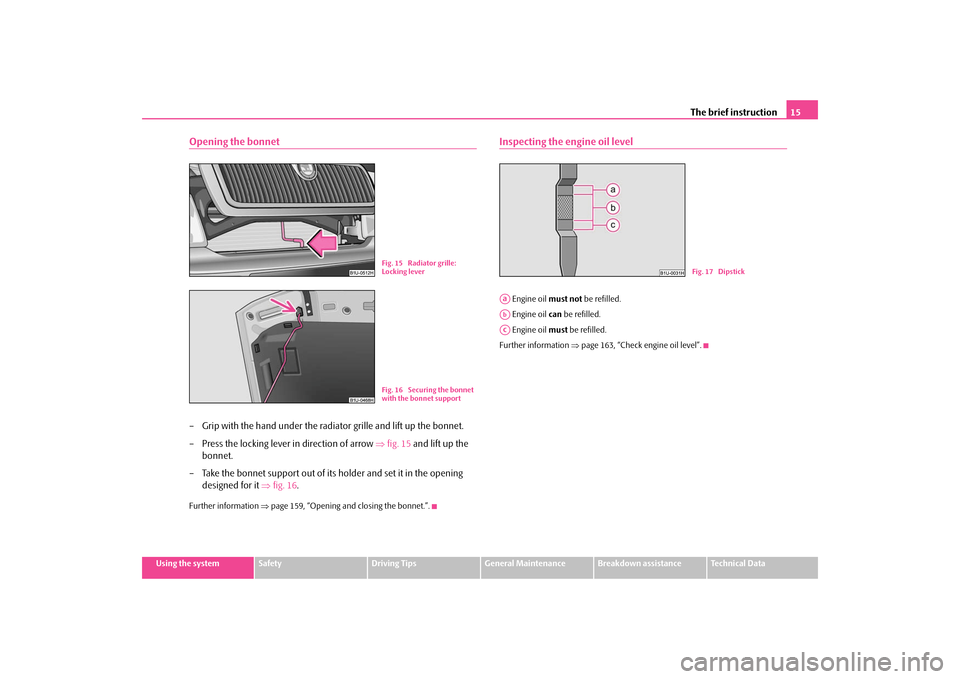
The brief instruction
15
Using the system
Safety
Driving Tips
General Maintenance
Breakdown assistance
Technical Data
Opening the bonnet– Grip with the hand under
the radiator grille and lift up the bonnet.
– Press the locking lever in direction of arrow
⇒
fig. 15
and lift up the
bonnet.
– Take the bonnet support out of its holder and set it in the opening
designed for it
⇒
fig. 16
.
Further information
⇒page 159, “Opening and closing the bonnet.”.
Inspecting the engine oil level Engine oil
must not
be refilled.
Engine oil
can
be refilled.
Engine oil
must
be refilled.
Further information
⇒page 163, “Check engine oil level”.
Fig. 15 Radiator grille: Locking leverFig. 16 Securing the bonnet with the bonnet support
Fig. 17 Dipstick
AaAbAc
s2g8.b.book Page 15 Tuesday, April 7, 2009 8:53 AM
Page 97 of 224
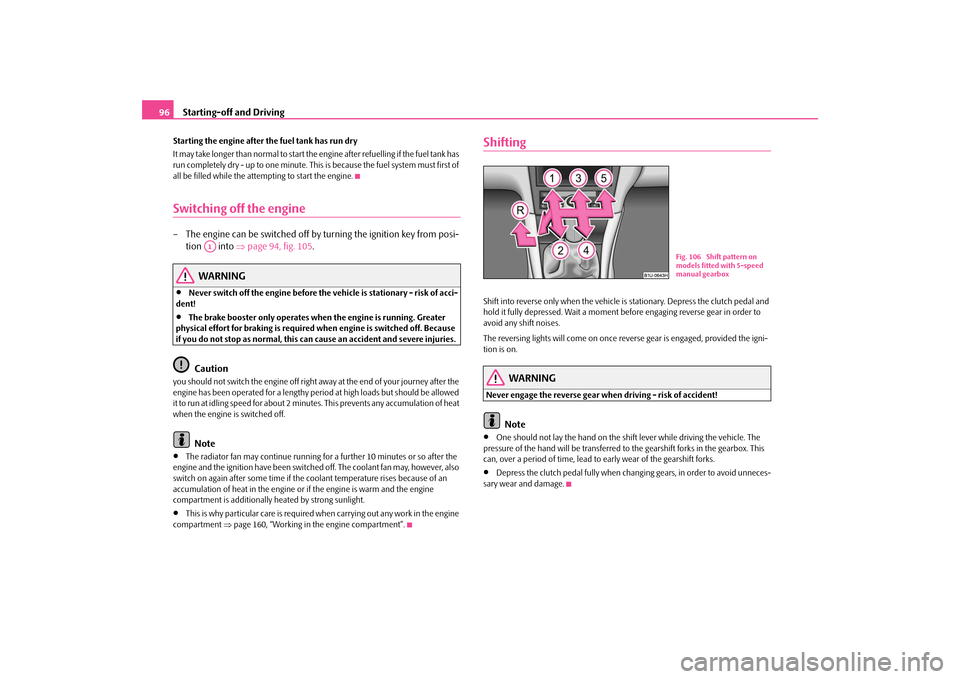
Starting-off and Driving
96
Starting the engine after the fuel tank has run dry It may take longer than normal to start the
engine after refuelling
if the fuel tank has
run completely dry - up to one minute. This is because the fuel system must first of all be filled while the attempting to start the engine.Switching off the engine– The engine can be swit
ched off by turning the ignition key from posi-
tion into
⇒
page 94, fig. 105
.
WARNING
•
Never switch off the engine before the
vehicle is stationary - risk of acci-
dent!•
The brake booster only operates when the engine is running. Greater
physical effort for braking is required
when engine is switched off. Because
if you do not stop as normal, this can cause an accident and severe injuries.
Caution
you should not switch the engine off right
away at the end of your journey after the
engine has been operated fo
r a lengthy period at high
loads but should be allowed
it to run at idling speed for about 2 minutes
. This prevents any accumulation of heat
when the engine is switched off.
Note
•
The radiator fan may continue running fo
r a further 10 minutes or so after the
engine and the ignition have been switched
off. The coolant fan may, however, also
switch on again after some time if the coolant temperature rises because of an accumulation of heat in the engine or
if the engine is warm and the engine
compartment is additionally
heated by strong sunlight.
•
This is why particular care is required when carrying out any work in the engine
compartment
⇒page 160, “Working in the engine compartment”.
ShiftingShift into reverse only when the vehicle is
stationary. Depress the clutch pedal and
hold it fully depressed. Wa
it a moment before engaging reverse gear in order to
avoid any shift noises. The reversing lights will come on once reverse gear is engaged, provided the igni- tion is on.
WARNING
Never engage the reverse gear when driving - risk of accident!
Note
•
One should not lay the hand on the shift lever while driving the vehicle. The
pressure of the hand will be transferred to
the gearshift forks in the gearbox. This
can, over a period of time, lead to
early wear of the gearshift forks.
•
Depress the clutch pedal fully when chan
ging gears, in order to avoid unneces-
sary wear and damage.
A1
Fig. 106 Shift pattern on models fitted with 5-speed manual gearbox
s2g8.b.book Page 96 Tuesday, April 7, 2009 8:53 AM
Page 160 of 224
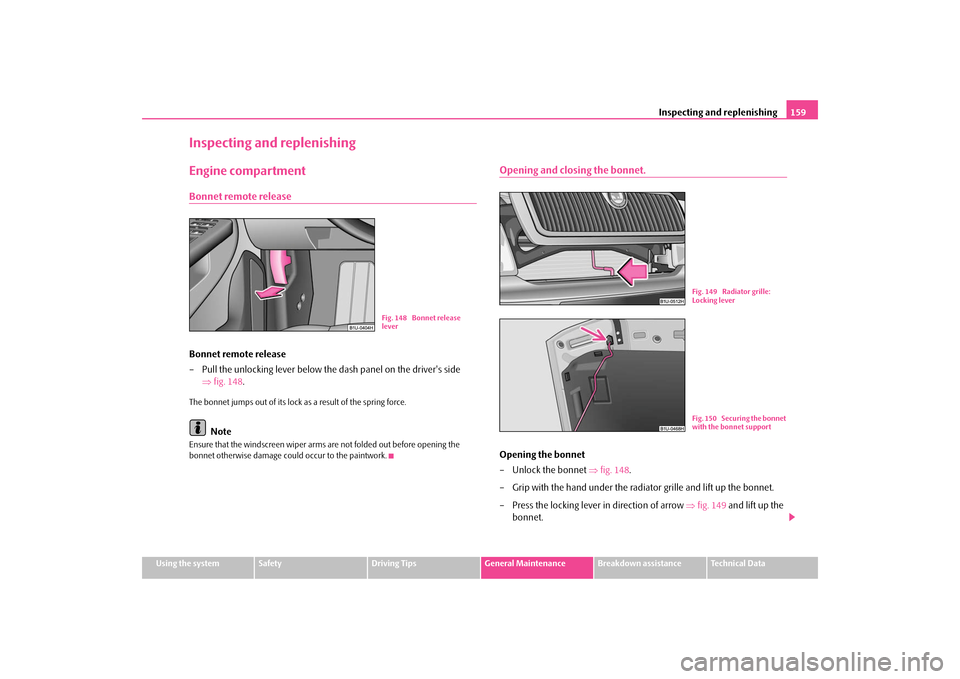
Inspecting and replenishing
159
Using the system
Safety
Driving Tips
General Maintenance
Breakdown assistance
Technical Data
Inspecting and replenishingEngine compartmentBonnet remote releaseBonnet remote release – Pull the unlocking lever below the
dash panel on the driver's side
⇒
fig. 148
.
The bonnet jumps out of its lock as a result of the spring force.
Note
Ensure that the windscreen wiper arms
are not folded out before opening the
bonnet otherwise damage coul
d occur to the paintwork.
Opening and closing the bonnet.Opening the bonnet – Unlock the bonnet
⇒
fig. 148
.
– Grip with the hand under the radiat
or grille and lift up the bonnet.
– Press the locking lever in direction of arrow
⇒
fig. 149
and lift up the
bonnet.
Fig. 148 Bonnet release lever
Fig. 149 Radiator grille: Locking leverFig. 150 Securing the bonnet with the bonnet support
s2g8.b.book Page 159 Tuesday, April 7, 2009 8:53 AM
Page 161 of 224
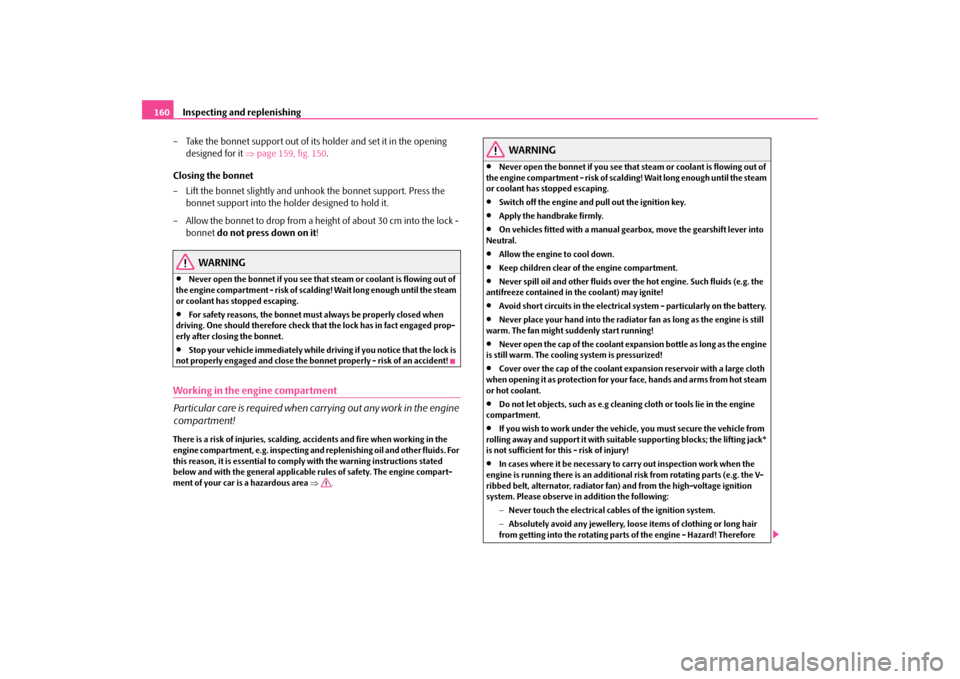
Inspecting and replenishing
160
– Take the bonnet support out of its holder and set it in the opening
designed for it
⇒
page 159, fig. 150
.
Closing the bonnet – Lift the bonnet slightly and unhook the bonnet support. Press the
bonnet support into the hold
er designed to hold it.
– Allow the bonnet to drop from a height of about 30 cm into the lock -
bonnet
do not press down on it
!
WARNING
•
Never open the bonnet if you see that steam or coolant is flowing out of
the engine compartment - risk of scaldi
ng! Wait long enough until the steam
or coolant has stopped escaping.•
For safety reasons, the bonnet must always be properly closed when
driving. One should therefore check that
the lock has in fact engaged prop-
erly after closing the bonnet.•
Stop your vehicle i
mmediately while driving if yo
u notice that the lock is
not properly engaged and close the bonn
et properly - risk of an accident!
Working in the engine compartment Particular care is required when ca
rrying out any work in the engine
compartment!There is a risk of injuries, scalding,
accidents and fire wh
en working in the
engine compartment, e.g. inspecting an
d replenishing oil and other fluids. For
this reason, it is essential to comply with the warning instructions stated below and with the general applicable
rules of safety. The engine compart-
ment of your car is a hazardous area
⇒
.
WARNING
•
Never open the bonnet if you see that steam or coolant is flowing out of
the engine compartment - risk of scaldi
ng! Wait long enough until the steam
or coolant has stopped escaping.•
Switch off the engine and pull out the ignition key.
•
Apply the handbrake firmly.
•
On vehicles fitted with a manual gearbox, move the gearshift lever into
Neutral.•
Allow the engine to cool down.
•
Keep children clear of the engine compartment.
•
Never spill oil and other fluids over the hot engine. Such fluids (e.g. the
antifreeze contained in the coolant) may ignite!•
Avoid short circuits in the electrical system - particularly on the battery.
•
Never place your hand into the radiator
fan as long as the engine is still
warm. The fan might suddenly start running!•
Never open the cap of the coolant expa
nsion bottle as long as the engine
is still warm. The cooling system is pressurized!•
Cover over the cap of the coolant expansion reservoir with a large cloth
when opening it as protection for your face, hands and arms from hot steam or hot coolant.•
Do not let objects, such as e.g cleaning cloth or tools lie in the engine
compartment.•
If you wish to work under the vehicl
e, you must secure the vehicle from
rolling away and support it
with suitable supporting blocks; the lifting jack*
is not sufficient for this - risk of injury!•
In cases where it be necessary to carry out inspection work when the
engine is running there is an additional risk from rotating parts (e.g. the V- ribbed belt, alternator, radiator fan) and from the high-voltage ignition system. Please observe in addition the following:
− Never touch the electrical cabl
es of the ignition system.
− Absolutely avoid any jewellery, loose items of clothing or long hair from getting into the rotating part
s of the engine - Hazard! Therefore
s2g8.b.book Page 160 Tuesday, April 7, 2009 8:53 AM
Page 168 of 224

Inspecting and replenishing
167
Using the system
Safety
Driving Tips
General Maintenance
Breakdown assistance
Technical Data
•
You should also consult a doctor without delay if you have inadvertently
swallowed coolant.
Caution
Do not continue your journey if for some reason it is not possible under the conditions prevailing to top up with coolant. Switch the engine off
and obtain
professional assistance from a specialist garage, otherwise it could lead to severe engine damage.
For the sake of the environment
Do not re-use coolant if it is necessary to
drain the coolant in the system. It should
be collected and disposed of in comp
liance with environmental protection
regulations.Radiator fan The radiator fan may switch on suddenly.The radiator fan is driven by an electr
ic motor and controlled according to the
coolant temperature. The radiator fan may continue running fo
r up to 10 minutes after the engine has
been switched off - even if
the ignition is also off. It
may also switch on suddenly
after a certain time, if•
the coolant temperature has risen beca
use of an accumulation of heat or
•
the warm engine compartment is heated
up additionally by
strong sunlight.
WARNING
You must therefore be aware when work
ing in the engine compartment that
the fan may switch on suddenly - risk of injury!
Brake fluidInspecting the brake fluid levelThe brake fluid reservoir is located on the left of the engine compartment. The brake fluid reservoir on right-hand steering models is positioned on the other side of the engine compartment. – Switch the engine off.– Open the bonnet
⇒
in “Working in the engine compartment” on
page 160.
– Inspect the brake fluid level in the reservoir
⇒
fig. 155
. The level must
be between the “MIN” and “MAX” markings.
A slight drop in the fluid level results when driving due to normal wear-and-tear and automatic adjustment of the br
ake pads, and is perfectly normal.
There may be an indication of a leak in the brake system, however, if the fluid level drops significantly within a short time or if it drops below the “MIN” marking. A situ- ation where the brake fluid level is too low is indicated by the warning light
lighting up in the instrument cluster
⇒page 34. In this case
stop immediately and
do not drive any further! Obtain professional assistance.
WARNING (continued)
Fig. 155 Engine compart- ment: Brake fluid reservoir
s2g8.b.book Page 167 Tuesday, April 7, 2009 8:53 AM
Page 173 of 224
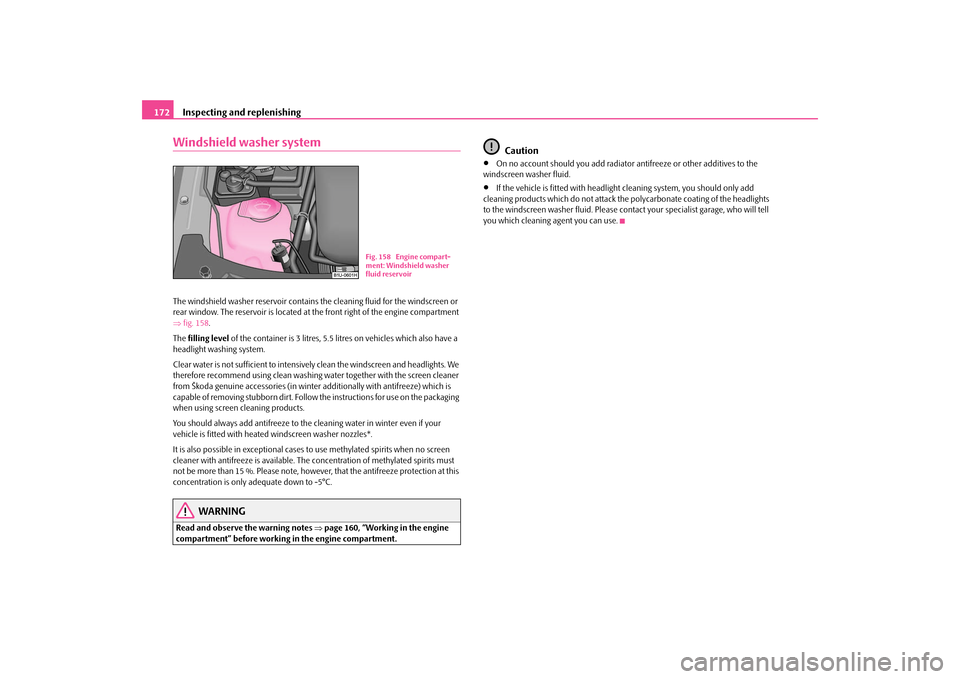
Inspecting and replenishing
172
Windshield washer systemThe windshield washer reservoir contains
the cleaning fluid for the windscreen or
rear window. The reservoir is located at the front right of the engine compartment ⇒ fig. 158
.
The
filling level
of the container is 3 litres, 5.5 li
tres on vehicles which also have a
headlight washing system. Clear water is not sufficient to intensivel
y clean the windscreen
and headlights. We
therefore recommend using clean washing wa
ter together with the screen cleaner
from Škoda genuine accessorie
s (in winter additionally with antifreeze) which is
capable of removing stubborn dirt. Follow
the instructions for use on the packaging
when using screen cleaning products. You should always add antifreeze to the
cleaning water in wi
nter even if your
vehicle is fitted with heated windscreen washer nozzles*. It is also possible in exceptional cases to use methylated spirits when no screen cleaner with antifreeze is
available. The concentration
of methylated spirits must
not be more than 15 %. Please note, howeve
r, that the antifreeze protection at this
concentration is only adequate down to -5°C.
WARNING
Read and observe the warning notes
⇒page 160, “Working in the engine
compartment” before working in the engine compartment.
Caution
•
On no account should you add radiator
antifreeze or other additives to the
windscreen washer fluid.•
If the vehicle is fitted with headlight
cleaning system, you should only add
cleaning products which do not attack th
e polycarbonate coating of the headlights
to the windscreen washer fluid. Please contact your specialist garage, who will tell you which cleaning agent you can use.
Fig. 158 Engine compart- ment: Windshield washer fluid reservoir
s2g8.b.book Page 172 Tuesday, April 7, 2009 8:53 AM
Page 194 of 224
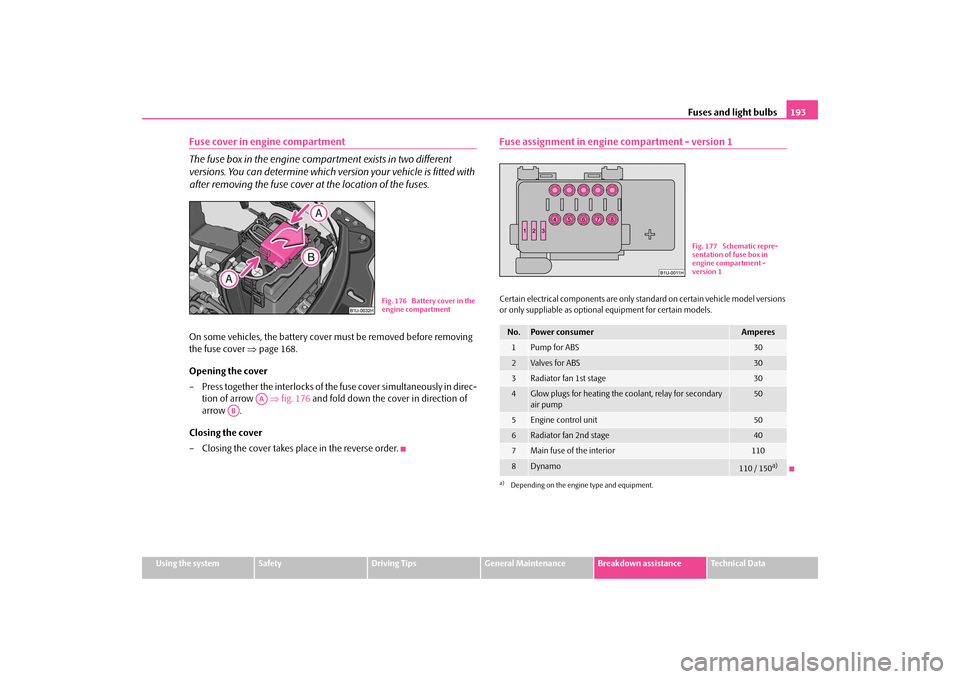
Fuses and light bulbs
193
Using the system
Safety
Driving Tips
General Maintenance
Breakdown assistance
Technical Data
Fuse cover in engine compartment The fuse box in the engine comp
artment exists in two different
versions. You can determine which version your vehicle is fitted with after removing the fuse cover at the location of the fuses.On some vehicles, the battery cover
must be removed before removing
the fuse cover
⇒
page 168.
Opening the cover – Press together the interlocks of th
e fuse cover simultaneously in direc-
tion of arrow
⇒
fig. 176
and fold down the cover in direction of
arrow .
Closing the cover – Closing the cover takes pl
ace in the reverse order.
Fuse assignment in engine compartment - version 1Certain electrical components are only standard on certain vehicle model versions or only suppliable as optional
equipment for certain models.
Fig. 176 Battery cover in the engine compartment
AA
AB
No.
Power consumer
Amperes
1
Pump for ABS
30
2
Valves for ABS
30
3
Radiator fan 1st stage
30
4
Glow plugs for heating the c
oolant, relay for secondary
air pump
50
5
Engine control unit
50
6
Radiator fan 2nd stage
40
7
Main fuse of the interior
110
8
Dynamo
110 / 150
a)
a)Depending on the engine type and equipment.
Fig. 177 Schematic repre- sentation of fuse box in engine compartment - version 1
s2g8.b.book Page 193 Tuesday, April 7, 2009 8:53 AM
Page 195 of 224
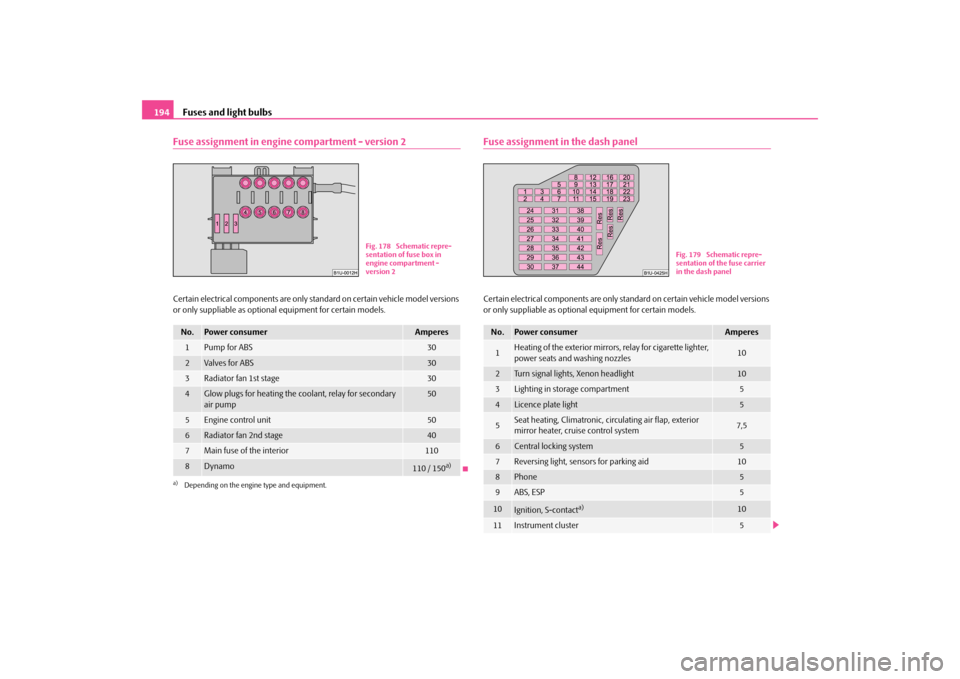
Fuses and light bulbs
194
Fuse assignment in engine compartment - version 2Certain electrical components are only st
andard on certain vehicle model versions
or only suppliable as optional
equipment for certain models.
Fuse assignment in the dash panelCertain electrical components are only standard on certain vehicle model versions or only suppliable as optional
equipment for certain models.
No.
Power consumer
Amperes
1
Pump for ABS
30
2
Valves for ABS
30
3
Radiator fan 1st stage
30
4
Glow plugs for heating the coolant, relay for secondary air pump
50
5
Engine control unit
50
6
Radiator fan 2nd stage
40
7
Main fuse of the interior
110
8
Dynamo
110 / 150
a)
a)Depending on the engine type and equipment.
Fig. 178 Schematic repre- sentation of fuse box in engine compartment - version 2
No.
Power consumer
Amperes
1
Heating of the exterior mirrors, relay for cigarette lighter, power seats and washing nozzles
10
2
Turn signal lights, Xenon headlight
10
3
Lighting in storage compartment
5
4
Licence plate light
5
5
Seat heating, Climatronic, circulating air flap, exterior mirror heater, cruise control system
7,5
6
Central locking system
5
7
Reversing light, sensors for parking aid
10
8
Phone
5
9
ABS, ESP
5
10
Ignition, S-contact
a)
10
11
Instrument cluster
5
Fig. 179 Schematic repre- sentation of the fuse carrier in the dash panel
s2g8.b.book Page 194 Tuesday, April 7, 2009 8:53 AM
Page 219 of 224
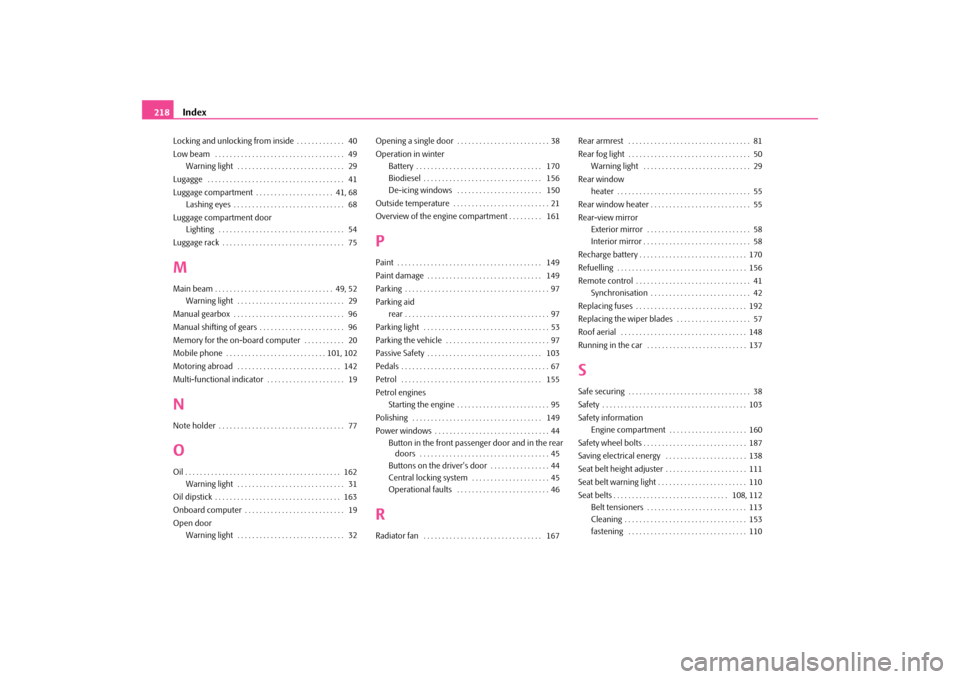
Index
218
Locking and unlocking from inside . . . . . . . . . . . . . 40 Low beam . . . . . . . . . . . . . . . . . . . . . . . . . . . . . . . . . . . 49
Warning light . . . . . . . . . . . . . . . . . . . . . . . . . . . . . 29
Lugagge . . . . . . . . . . . . . . . . . . . . . . . . . . . . . . . . . . . . . 41 Luggage compartment . . . . . . . . . . . . . . . . . . . . . 41, 68
Lashing eyes . . . . . . . . . . . . . . . . . . . . . . . . . . . . . . 68
Luggage compartment door
Lighting . . . . . . . . . . . . . . . . . . . . . . . . . . . . . . . . . . 54
Luggage rack . . . . . . . . . . . . . . . . . . . . . . . . . . . . . . . . . 75MMain beam . . . . . . . . . . . . . . . . . . . . . . . . . . . . . . . . 49, 52
Warning light . . . . . . . . . . . . . . . . . . . . . . . . . . . . . 29
Manual gearbox . . . . . . . . . . . . . . . . . . . . . . . . . . . . . . 96 Manual shifting of gears . . . . . . . . . . . . . . . . . . . . . . . 96Memory for the on-board computer . . . . . . . . . . . 20 Mobile phone . . . . . . . . . . . . . . . . . . . . . . . . . . . 101, 102 Motoring abroad . . . . . . . . . . . . . . . . . . . . . . . . . . . . 142Multi-functional indicator . . . . . . . . . . . . . . . . . . . . . 19NNote holder . . . . . . . . . . . . . . . . . . . . . . . . . . . . . . . . . . 77OOil . . . . . . . . . . . . . . . . . . . . . . . . . . . . . . . . . . . . . . . . . . 162
Warning light . . . . . . . . . . . . . . . . . . . . . . . . . . . . . 31
Oil dipstick . . . . . . . . . . . . . . . . . . . . . . . . . . . . . . . . . . 163 Onboard computer . . . . . . . . . . . . . . . . . . . . . . . . . . . 19Open door
Warning light . . . . . . . . . . . . . . . . . . . . . . . . . . . . . 32
Opening a single door . . . . . . . . . . . . . . . . . . . . . . . . . 38 Operation in winter
Battery . . . . . . . . . . . . . . . . . . . . . . . . . . . . . . . . . . 170Biodiesel . . . . . . . . . . . . . . . . . . . . . . . . . . . . . . . . 156De-icing windows . . . . . . . . . . . . . . . . . . . . . . . 150
Outside temperature . . . . . . . . . . . . . . . . . . . . . . . . . . 21 Overview of the engine compartment . . . . . . . . . 161PPaint . . . . . . . . . . . . . . . . . . . . . . . . . . . . . . . . . . . . . . . 149 Paint damage . . . . . . . . . . . . . . . . . . . . . . . . . . . . . . . 149Parking . . . . . . . . . . . . . . . . . . . . . . . . . . . . . . . . . . . . . . . 97 Parking aid
rear . . . . . . . . . . . . . . . . . . . . . . . . . . . . . . . . . . . . . . . 97
Parking light . . . . . . . . . . . . . . . . . . . . . . . . . . . . . . . . . . 53Parking the vehicle . . . . . . . . . . . . . . . . . . . . . . . . . . . . 97 Passive Safety . . . . . . . . . . . . . . . . . . . . . . . . . . . . . . . 103 Pedals . . . . . . . . . . . . . . . . . . . . . . . . . . . . . . . . . . . . . . . . 67Petrol . . . . . . . . . . . . . . . . . . . . . . . . . . . . . . . . . . . . . . 155 Petrol engines
Starting the engine . . . . . . . . . . . . . . . . . . . . . . . . . 95
Polishing . . . . . . . . . . . . . . . . . . . . . . . . . . . . . . . . . . . 149Power windows . . . . . . . . . . . . . . . . . . . . . . . . . . . . . . . 44
Button in the front passen
ger door and in the rear
doors . . . . . . . . . . . . . . . . . . . . . . . . . . . . . . . . . . . 45 Buttons on the driver's door . . . . . . . . . . . . . . . . 44Central locking system . . . . . . . . . . . . . . . . . . . . . 45Operational faults . . . . . . . . . . . . . . . . . . . . . . . . . 46
RRadiator fan . . . . . . . . . . . . . . . . . . . . . . . . . . . . . . . . 167
Rear armrest . . . . . . . . . . . . . . . . . . . . . . . . . . . . . . . . . 81 Rear fog light . . . . . . . . . . . . . . . . . . . . . . . . . . . . . . . . . 50
Warning light . . . . . . . . . . . . . . . . . . . . . . . . . . . . . 29
Rear window
heater . . . . . . . . . . . . . . . . . . . . . . . . . . . . . . . . . . . . 55
Rear window heater . . . . . . . . . . . . . . . . . . . . . . . . . . . 55 Rear-view mirror
Exterior mirror . . . . . . . . . . . . . . . . . . . . . . . . . . . . 58Interior mirror . . . . . . . . . . . . . . . . . . . . . . . . . . . . . 58
Recharge battery . . . . . . . . . . . . . . . . . . . . . . . . . . . . . 170 Refuelling . . . . . . . . . . . . . . . . . . . . . . . . . . . . . . . . . . . 156 Remote control . . . . . . . . . . . . . . . . . . . . . . . . . . . . . . . 41
Synchronisation . . . . . . . . . . . . . . . . . . . . . . . . . . . 42
Replacing fuses . . . . . . . . . . . . . . . . . . . . . . . . . . . . . . 192 Replacing the wiper blades . . . . . . . . . . . . . . . . . . . . 57 Roof aerial . . . . . . . . . . . . . . . . . . . . . . . . . . . . . . . . . . 148Running in the car . . . . . . . . . . . . . . . . . . . . . . . . . . . 137SSafe securing . . . . . . . . . . . . . . . . . . . . . . . . . . . . . . . . . 38 Safety . . . . . . . . . . . . . . . . . . . . . . . . . . . . . . . . . . . . . . . 103 Safety information
Engine compartment . . . . . . . . . . . . . . . . . . . . . 160
Safety wheel bolts . . . . . . . . . . . . . . . . . . . . . . . . . . . . 187 Saving electrical energy . . . . . . . . . . . . . . . . . . . . . . 138 Seat belt height adjuster . . . . . . . . . . . . . . . . . . . . . . 111Seat belt warning light . . . . . . . . . . . . . . . . . . . . . . . . 110 Seat belts . . . . . . . . . . . . . . . . . . . . . . . . . . . . . . . 108, 112
Belt tensioners . . . . . . . . . . . . . . . . . . . . . . . . . . . 113Cleaning . . . . . . . . . . . . . . . . . . . . . . . . . . . . . . . . . 153 fastening . . . . . . . . . . . . . . . . . . . . . . . . . . . . . . . . 110
s2g8.b.book Page 218 Tuesday, April 7, 2009 8:53 AM